Why the fight to save the rare Leadbeater’s possum threatens to fell the native timber industry
How did this cute little critter turn the tables on the native timber industry?
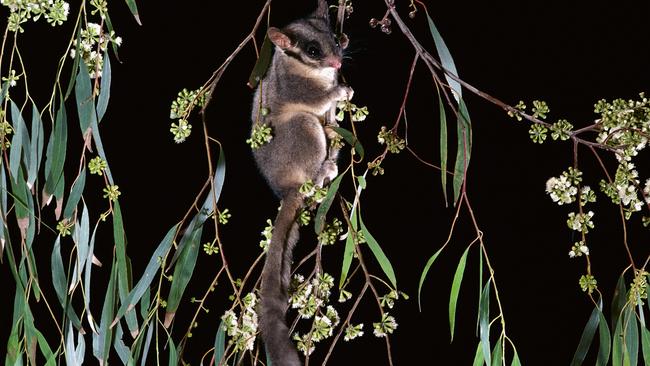
On April 3, 1961, a 22-year-old junior in the fossils department of Melbourne Museum was walking at night in the mountain ash forest near the logging town of Cambarville, 150km east of Melbourne, when his torch beam fell upon two piercing eyes staring back at him in the bushes. A member of the Field Naturalists Club, Eric Wilkinson knew what he was seeing – he just didn’t believe it. Because the animal he was looking at wasn’t thought to exist.
Wilkinson had found himself face-to-face with a Leadbeater’s possum, a marsupial first described in 1867 but not seen for more than 50 years and presumed extinct. The museum didn’t believe him at first but eventually sent an official expedition that went back into the forest, found another possum and – to Wilkinson’s dismay – shot it. Now they had a specimen. Over the next 15 years the elusive animal was recorded in just 50 sites. In 1971 it became one of Victoria’s faunal emblems, the only mammal endemic to that state, and in 2015 it was listed as critically endangered. Best estimates are that about 2000-4000 are confined to one region in Victoria’s Central Highlands.
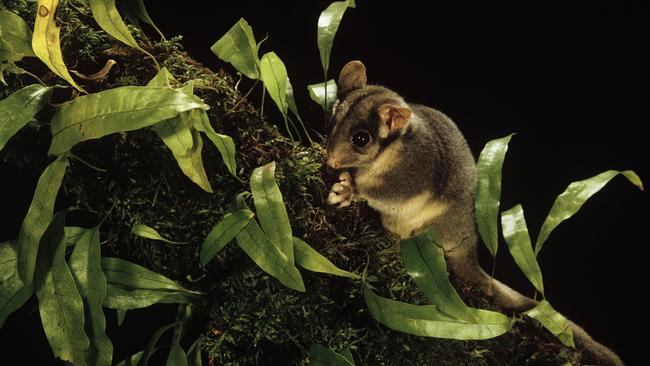
That it was found near Cambarville, a logging town, was no accident. The possum and many other native animals share with the forestry industry an attraction to the majestic mountain ash trees that dominate the Central Highlands. The old hollow-bearing trees make great nesting sites. They also make great kitchen benches, although government figures show just 13 per cent of native forest logged in Victoria becomes timber products.
In May this year, the Leadbeater’s possum and another vulnerable marsupial, the greater glider, took centre stage in a Federal Court case launched by a small community group against Victoria’s state-owned logging agency, VicForests. In a landmark ruling, the court decided VicForests had been logging unlawfully in 26 areas of habitat critical to the two mammals, and planned to log unlawfully in 41 more. Four more groups have filed legal action against the agency and at least 92 logging zones covering about 3575ha are now under injunction. Already struggling to fulfil wood pulp contracts after years of logging, plus losing forest to bushfires and now court cases, VicForests’ preferred native timber supply is fast drying up, and with it Victoria’s native timber industry. It’s an industry already on its last legs since the Andrews Government announced it would be phased out from 2024, ending in 2030. But many doubt it will last that long.
Outside Victoria the forestry industry is on alert as the broader ramifications of the judgment sink in. Smelling blood in the water, the Bob Brown Foundation has lodged its own Federal Court case against Tasmanian state-owned logging agency Sustainable Timber Tasmania, challenging the validity of the legal framework forestry operates under. It hopes a win will achieve an immediate ban on native timber logging and open doors for similar action in other states.
But what no court or government can control, and what insiders say the industry is most worried about, is the waning social licence for native forest products, something the country’s most powerful retailers are all too aware of. In July, four weeks after the Federal Court judgment, hardware giant Bunnings announced it was dumping VicForests timber from its shelves. It wasn’t a gentle breakup. “Bunnings has a zero-tolerance approach to illegally logged timber,” was the company’s unambiguous statement. Officeworks is also cutting ties and from December will stock only products approved by the Forest Stewardship Council (FSC), the global certification system that gives a tick to native forest products judged to have come from responsibly managed sources.
These events have left the native timber industry shell-shocked. They argue that minor environmental breaches are negligible and inevitable, and that climate change and bushfires are a far greater threat to the Leadbeater’s possum than logging. The possums are doing fine, they say; it’s people’s livelihoods – in a state already struggling with economic collapse wrought by the latest Covid-19 lockdown – that are critically endangered.
The Leadbeater’s possum may be tiny – it weighs just 135g and would fit in the palm of your hand – but the campaign waged in its name has been colossal. The Victorian emblem could become emblematic for bringing an industry to its knees.
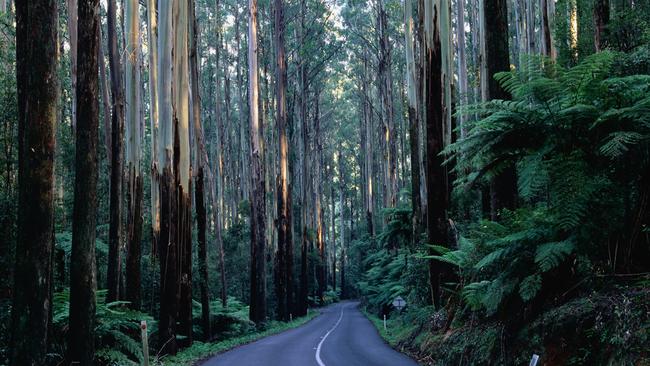
Mountain ash trees dominate the Toolangi State Forest, 75km north-east of Melbourne. Reaching about 90m high, they’re one of the tallest flowering trees in the world, so tall they look out of proportion. “Do you know how a Leadbeater’s possum makes its nest?” asks Steve Meacher, 67. He’s president of Friends of Leadbeater’s Possums, a small group that crowdsourced at least $200,000 to mount the historic case against VicForests. “Thousands of people got behind this case and supported it. The whole thing has been a community effort.” With his ripped jeans and old car, he doesn’t strike you as someone who has just humiliated a powerful government agency in a landmark court case that could bring down an entire industry.
Meacher cranes his head to the canopy as we make our first stop on a tour of the state park. “They find a very small crack in the trunk then chew around the crack until it’s just big enough for them to squeeze through,” he says. “Then they gather streamers of eucalyptus bark, tear it into strips, gather it up in a bundle, wrap it in their tail and drag it back to their nest where they chew it up until it’s like wool. They burrow into the wool and that becomes their nest.”
Leadbeater’s possums need a mix of ageing or dead trees with hollows where they build their nests, and a younger, diverse understorey where they forage for food and travel through the forest. Some of the tallest mountain ash trees are called “stags” because of the dead branches that protrude like antlers when the top of the tree is blown off by lightning, or starves and rots away in dry times due to the sheer effort of sucking water up that high. Stags make great habitat trees for “Leadies”, but also for greater gliders and a variety of birds.
There’s also plenty happening at ground level as we make our way through the bush. We nibble on spicy mountain pepper, caress the soft underbelly of a blanket leaf, crush the leaves of the aptly named stinkwood in our fingers, push through forest wire-grass that clings to our pants, get tangled in tanglewood. Then we burst out of the dense, complex forest and into the blinding light and the barren expanse of a freshly razed forestry coupe. “Well, here we are!” says Meacher.
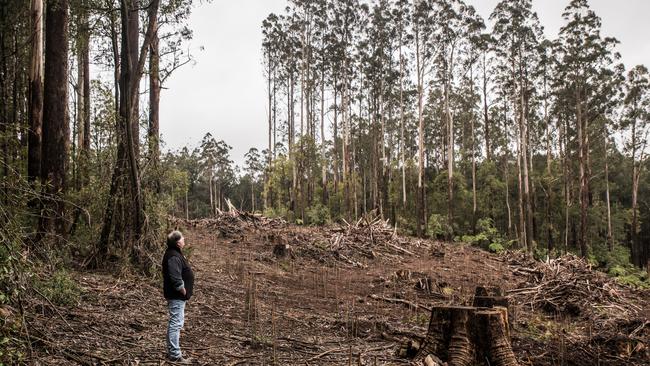
Coupes are the areas designated for logging. VicForests gives them names. The first one we see is called Gags. “Groups of coupes have themes,” says Meacher. “Up that ridge is Funny and past the creek is Jokes.” VicForests is supposed to retain a 20m buffer between coupes and roads but Gags has been felled right up to the shoulder. It seems a relatively minor issue compared with the bulk of the evidence presented in court that showed VicForests had been logging (and intended to log) in 66 coupes where threatened species were found to be living. To gauge where threatened species exist, VicForests is required to carry out surveys prior to harvesting, but evidence presented in court showed it wasn’t always doing this.
Getting that evidence wasn’t easy. Another volunteer-run group, Wildlife of the Central Highlands (WOTCH), spent years going out into the bush at night and surveying for Leadbeater’s possums and greater gliders. WOTCH president Hayley Forster says the group seeks out likely habitat trees using an infrared camera and searches for reflective eyes in the torchlight. “When we spot a possum we film it and then pan across to a GPS to record the co-ordinate, all in one shot.”
WOTCH will have its day in Victoria’s Supreme Court next month when it will allege that VicForests breached the precautionary principle again by logging in unburnt areas remaining from last summer’s devastating bushfires without waiting for surveys to be done on the impacts of those fires on threatened species. Forster says the area currently being logged is the last refuge for animals such as the greater glider, powerful owl, sooty owl, smoky mouse and alpine tree frog. “Those species lost such large portions of their forests through East Gippsland that those unburnt areas are so critical now. But it’s been business as usual for VicForests.”
VicForests doesn’t contest that it harvests timber in areas likely to contain threatened species; it argues that state law allows it, and that not being able to do so would shut down its entire operation in the Central Highlands. But what about federal environment laws that are supposed to protect threatened species – why does VicForests think it is exempt from those? That’s exactly what was tested in the Federal Court.
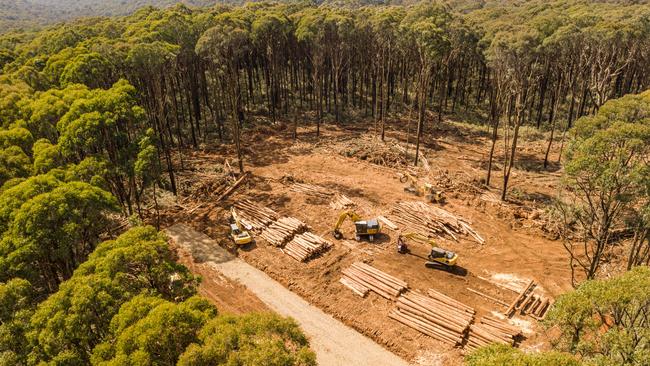
It works a bit like this. Say you want to carry out a major project in an area that’s home to federally listed threatened species. Ordinarily you would need permission from the federal environment minister under the Environment Protection and Biodiversity (EPBC) Act. But things are a little different when it comes to forestry.
In response to the “forest wars” of the 1980s and 1990s, former prime minister Paul Keating introduced Regional Forestry Agreements (RFAs) between the Commonwealth and four state governments – NSW, Victoria, Tasmania and Western Australia – that grant forestry an exemption from the EPBC Act. But it’s not a get-out-of-jail-free card. VicForests must comply with the Victorian Code of Practice for Timber Production and if the code is breached, the exemption is lost. The Federal Court found that VicForests’ practices did not comply with the code and therefore contravened the EPBC Act in all 66 coupes. Those coupes are subject to a final injunction and VicForests will need to apply to the federal environment minister if it wants to resume logging there. In a statement VicForests (which declined requests for an interview) said it had introduced new methods of timber harvesting to mitigate impacts on threatened species, and that its operations were “scrutinised by the Office of the Conservation Regulator under rigorous rules and guidelines”.
VicForests lodged an appeal against the decision last Friday. It maintains the ruling was based on a “mis-characterisation” of its obligations under both state law and the EPBC Act.
Meacher says the ruling was even better than he’d hoped for. “It was an extraordinary decision. She [the judge] found we had proved breaches of the code in every case we alleged.” Justice Debra Mortimer’s 451-page judgment was indeed scathing. She found the evidence of VicForests’ expert witnesses to be neither strong nor independent. She said VicForests relied on desktop modelling to predict where threatened species might be, rather than going out and looking. She also had little confidence in its “new” forestry methods, which she found were not designed for conservation but driven by commercial motivations. “The evidence suggests, and I find, that the purpose and intention of VicForests’ undertaking this new policy and these new methods is to secure FSC accreditation so that it derives a commercial benefit – such as getting its products into places like Bunnings. The modifications are not being undertaken for conservation purposes.” The judge said there was a clear conflict in VicForests acting as both a commercial harvester of native timber and as a forest conservator. “VicForests regard species such as the greater glider as an inconvenience – an interruption to its timber harvesting programs” was Justice Mortimer’s blunt assessment.
If there’s one thing environmentalists and the forestry industry agree on it’s that this decision has put the industry at a tipping point. “If the [Federal Court] judgment stands there’s no reason it wouldn’t apply in all states,” says Ross Hampton, CEO of timber body Australian Forest Products Association (AFPA). “This is a threshold moment for our political leaders. Will we have a sustainable, modest and very important native forestry industry in Australia in the future or not? Will we have those tens of thousands of jobs or not? Will we have the wood that supplies our homes and offices with beautiful, appearance grade timber or not? Because if there isn’t a correction made, if the state and federal governments don’t come together and take out of play this interpretation that has emerged, then that’s where we’re going to end up.”
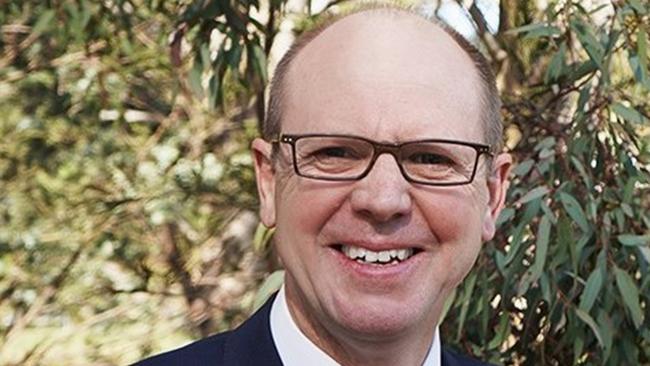
The way mill worker Kerri Chivers tells it, timber is to Heyfield what sand is to the Gold Coast. A leading hand at the Australian Sustainable Hardwoods (ASH) sawmill, 200km east of Melbourne, she grew up across the road from the old Forests Commission Victoria building. For her, native forestry is more than an income, it’s a regional identity. ASH sponsors the netball and football clubs (Chivers is president of the netball club) and timber from the mill is used in the clubrooms. Chivers sees the conflict through the prism of inner-city elites versus the bush and believes timber workers are treated as disposable by city politicians and unfairly painted as environmental vandals. She reserves special anger for Bunnings, saying it has let down the communities it serves by refusing to take the wood supplied by the local mill. “It’s just another kick. When you work in the timber industry you get used to being booted by someone, somewhere,” she says. “This Bunnings decision is going to affect so many people. During the lockdown I was spending $200 a week minimum in there. But I haven’t set foot in there since.”
The CFMMEU organised a truck blockade of Bunnings’ Traralgon store in Gippsland to protest against the retailer’s decision. Union pressure to keep the industry going remains a headache for the Andrews Government, which has already paid about $60 million to bail out ASH, becoming a 49 per cent shareholder after Victoria’s largest hardwood sawmill faced closure in 2017 due to dwindling timber supply. The mill now employs 170 people.
VicForests-supplied sawlogs leave the factory as finished components for products such as kitchen benches and staircases. Mountain ash (also called Tasmanian oak) is a prized hardwood and Chivers says she gets tremendous pride from manufacturing high-end local products. “We get photos back from stuff we’ve sent out for special projects and it just looks amazing.” She says she went to Melbourne two years ago and noticed something interesting about the trees in the city. “We couldn’t get over the fact they had guarding around the trunks to keep the possums off. So it’s OK for them to keep the possums out of the trees in Melbourne but they want to shut down an industry out here to save a possum? And those Leadbeater’s possums, there are heaps of them anyway. Guys from work went looking for them and found them everywhere.”
Chivers is referring to a new income stream for VicForests. Last financial year it earned more than $11 million in government grants as compensation for not being able to log in a 200m buffer zone around where any possum is found. Since 2014 more than 500 new colonies have been found and there are now 688 buffer zones in place. Professor David Lindenmayer from Australian National University says these numbers may be misleading, however, as animals are likely to be counted multiple times. Lindenmayer found the population has in fact declined by more than 50 per cent over the past 22 years and that decline relates directly to how much forest has been logged.
The timber industry points to another study from University of Melbourne, partly funded by VicForests, that found bushfires were the main threat to Leadbeater’s possums. The industry believes there are a lot more possums than we think, possibly upwards of 20,000. Wishful thinking, says Steve Meacher. “It simply shows an increase in the effort that goes into looking for them, because there’s a reason to do so now.”
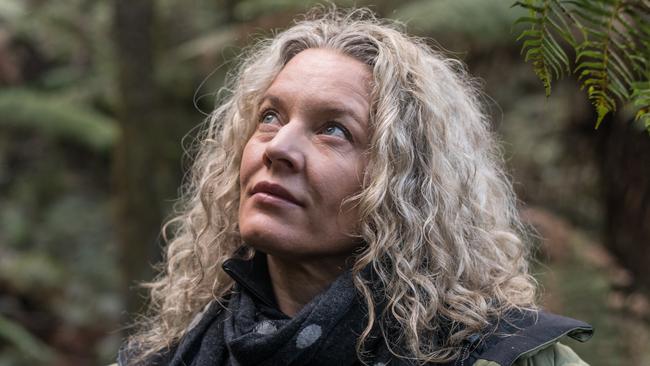
The most recent court win stirs deep emotion forHealesville local Sarah Rees, who led a community group that took VicForests to court back in 2011 over logging that continued after the Black Saturday bushfires in 2009. She says the Leadbeater’s possum lost around 50 per cent of its habitat in one afternoon. “People had given their lives to try to protect this forest, then as soon as the fire was out that same forest was coming out on the back of trucks and heading off to the woodchip factory,” she says, as we walk through ancient fern gullies and mountain ash forest at Badgers Weir, part of Yarra Ranges National Park.
Rees’s group lost the case and was ordered to pay VicForests’ costs of $1.25 million (which remains unpaid). She says during that period she was subjected to violence and intimidation. “They burgled my house, ran me off the road with my two babies in the back of the car, then ran over my dog. I was abused, had rape threats, death threats, my mail was constantly stolen.” But in the years since, Rees says the breeze has noticeably shifted. “Healesville used to be a timber town, now it’s a tourism town.” Today she’s more likely to be congratulated than castigated, she says.
A 2018 Rural Wellbeing Survey of 11,500 people commissioned by the Forest and Wood Products Association found that native forest harvesting was considered acceptable by just 17 per cent of rural and regional residents, and that the industry typically employs less than 5 per cent of any given community. The Victorian Government has put forward a $120 million transition package to plantation-only timber by 2030 and Federal Government figures show that the state already harvests more than seven times more plantation logs than native forest logs.
Despite her years of campaigning, Rees doesn’twant to see the end of the native timber industry. “I think it does a disservice to regional communities to remove an asset that we could be utilising in a sustainable way to generate jobs. But we’re clearing forest that’s nearly 100 years old to turn into a piece of paper or cardboard. What we need to do is remove the pulp dependency.”
But that dependency is etched in legislation. Most of the native forest felled in the Central Highlands is destined not for kitchen benches or staircases but for Opal Australian Paper’s Maryvale mill, owned by Japanese company Nippon, to be turned into pulp and paper. The Victorian Government is bound by an act of parliament to supply the mill with at least 350,000 cubic metres of logs under a fixed price each year. The Wood Pulp Agreement is due to expire in 2030, the year nominated by the Andrews Government for native logging to end. A 2017 Victorian Parliamentary Inquiry into VicForests’ operations found the agreement “continues to cost the government and place pressure on state forests to deliver low-grade timber that could be sourced elsewhere”.
This explains in large part the pressure VicForests is under to supply large volumes of timber from the Central Highlands. Failure to supply enough wood to Opal Australian Paper results in a penalty payable by the government. In March the Herald Sun reported that the Andrews Government gave Opal Australian Paper $200 million in a “secret deal” to secure the mill’s future. Following a complaint by the Wilderness Society the Commonwealth Ombudsman is investigating whether the company could be breaching the Illegal Logging Prohibition Act by taking timber from VicForests. Opal Australian Paper didn’t respond to a request for comment.
VicForests receives generous taxpayer subsidies, but losses on its logging operations have trebled over the past three years. It lost $15 million on those operations last year. A 2016 PwC audit found that VicForests is “not competitive or financially viable”, and that for every dollar of investment it returns 14 cents, providing “minimal economic and employment return on investment”. VicForests points to a Deloitte Access Economics report that found the agency and its contractors generated $112 million in revenue in 2015-16, during its heyday of harvesting.
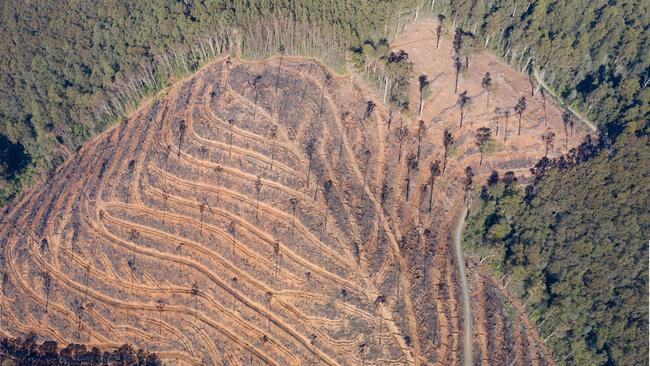
Bunnings’ patience with VicForests’ repeated attempts to gain FSC certification was long running thin. VicForests was assessed in 2018 but rejected, one of multiple rejections dating back to 2008. In April it lost its membership of FSC entirely. Following Bunnings’ decision to end its timber supply contract VicForests announced it would withdraw its latest attempt to gain certification, claiming three of FSC Australia’s directors (one of whom is Sarah Rees) were actively campaigning against native forestry and “seeking to discredit VicForests”. FSC Australia rejects this, saying all assessments are carried out by independent auditors.
Bunnings insists it won’t increase the amount of imported timber to make up any shortfall from dumping VicForests. It says that while about 80 per cent of its timber products come from plantations, it does import natural forest timber, such as Meranti from Malaysia and FSC-certified Merbau from West Papua, both of which are claimed to be “sourced from lawful and responsibly managed operations”. Plenty are sceptical about that. “Most people understand we need timber,” says AFPA’s Ross Hampton. “And if it doesn’t come from Australia, it’s going to come from overseas.”
Amelia Young from the Wilderness Society says the Bunnings decision shouldn’t come as a surprise to anyone. “Australians don’t want illegally logged timber in their homes or gardens, and Bunnings doesn’t want it on its shelves. It’s clear that major Australian retailers can’t afford to be associated with illegally logged native forests any more than they could import tools made of ivory or furniture upholstered with tiger skin.” But Hampton resents the term “illegal logging” being used in an Australian context. “When the public think illegal logging, they generally think of land clearing by pirate gangs in South-East Asia or Africa. Environmentalists are translating that picture to Victoria and now trying to do it in Tasmania. There’s no equivalent. There will always be the occasional misstep by our forestry agencies. But if we’re not going to disturb our wildlife all we’re saying is we’re prepared to denude someone else’s country… How are the orang-utans faring in the cleared rainforests of Borneo?”
The Federal Court decision came as a huge shock to the Victorian Government as it struggles to string out the industry another 10 years. In response it said it would review the timber code of practice, an announcement welcomed by the timber industry but regarded with deep suspicion by conservationists. The Weekend Australian Magazine understands that to prevent further legal challenges, the Victorian Government is looking at options to remove the precautionary principle and third-party rights to sue. Hampton is pushing for any changes that will serve to restore the separation between RFAs and the EPBC Act and stop the “lawfare”. “We’d like to go back to what everyone understood the agreement was, which is that the EPBC Act isn’t involved because the RFAs are managed at a state level.” Legislative changes to the EPBC Act now working their way through federal parliament may help grant his wish, as the Federal Government seeks to further devolve environmental assessments of all major projects to the states.
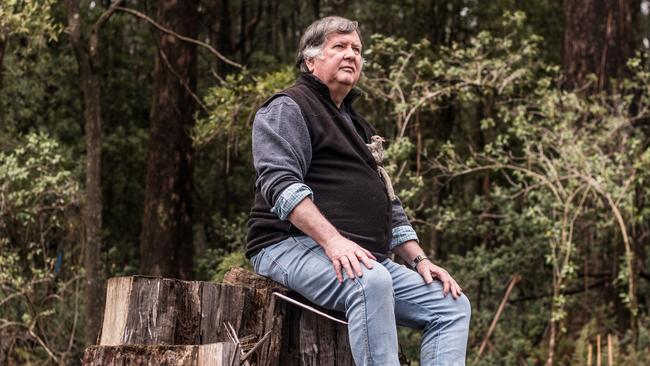
Evening falls in the forest. Steve Meacher leads the way to our last stop, a clearing where dozens of logs lie side-by-side in the mud like a mass grave. Lemony shards of sunlight slip between the mountain ash. Meacher fixes his gaze on the bush. “In 2012 a Leadbeater’s possum was photographed in a nest tree right here, so we got an injunction to stop them felling. The day we got that injunction they came in here and bulldozed all the understorey around that nest tree so the possums wouldn’t be able to access their nest. They had nothing to gain by doing that. It was pure bloody- mindedness.” He turns and starts walking off.
“What’s this coupe called?” I call out after him.
“Gun Barrel,” he says. The smooth, grey trunks of mountain ash hang behind him like a curtain. He disappears into it.

To join the conversation, please log in. Don't have an account? Register
Join the conversation, you are commenting as Logout